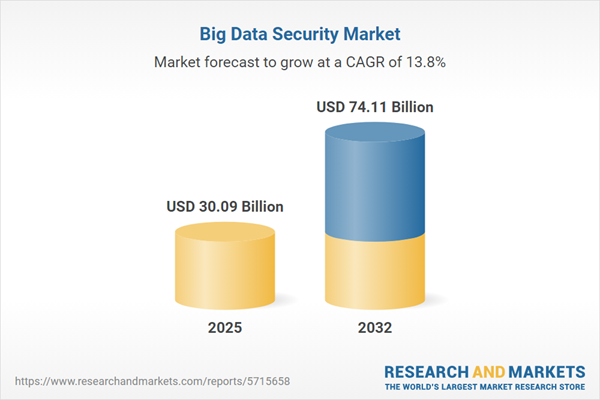Speak directly to the analyst to clarify any post sales queries you may have.
As digital transformation accelerates, senior leaders recognize that robust big data security is integral to safeguarding enterprise operations and supporting resilient business strategies. Adaptive risk management and regulatory alignment are becoming foundational as organizations navigate evolving cyber threats and compliance environments.
Market Snapshot: Big Data Security Market Outlook
The global big data security market is experiencing steady expansion, currently valued at USD 26.41 billion with a projected compound annual growth rate (CAGR) of 13.76%. Expanding reliance on cloud computing and hybrid environments is prompting enterprises to boost investments in agile security approaches. Heightened regulatory enforcement and the growing variety of cyber risks are key drivers shaping strategic decision-making in this sector. Adoption rates remain highest in North America and Europe, where advanced data governance protocols foster proactive compliance. At the same time, rapid digitalization and changing regulations are fostering strong momentum across Asia-Pacific and Latin America. Across all geographies, organizations are fine-tuning their security programs to keep pace with sophisticated threat patterns and shifting legal requirements.
Scope & Segmentation of Big Data Security Solutions
- Component: Managed services offer organizations continuous monitoring, rapid incident response, and guidance on regulatory best practices. Professional services focus on tailored integration and aligning security with sector compliance frameworks. Comprehensive software platforms ensure seamless adaptation to evolving IT environments.
- Deployment Type: Flexible security solutions support hybrid, private, and public cloud as well as on-premises systems, helping enterprises manage sector-specific requirements and streamline compliance processes.
- Organization Size: Large enterprises integrate advanced solutions to manage highly complex, distributed technology stacks. Small and mid-sized businesses benefit from tools that provide strong security without sacrificing operational efficiency or adaptability.
- Security Type: Complete enterprise defense includes encryption, network protection, identity and access management, automated compliance tools, behavioral analytics, continuous threat monitoring, and dynamic analytics to mitigate risk.
- Application: Sectors such as finance, healthcare, government, manufacturing, information technology, retail, telecommunications, and e-commerce deploy specialized frameworks to address unique compliance pressures and privacy concerns.
- Regional Coverage: Adoption patterns depend on regional compliance mandates and operational risk climates. North America and Europe prioritize rigorous oversight, while Asia-Pacific and Latin America drive agile strategies to adapt to shifting standards. The Middle East and Africa address layered legal contexts by partnering with local experts for tailored risk mitigation.
- Leading Companies: Providers like Microsoft, Cisco Systems, Palo Alto Networks, Fortinet, Broadcom, IBM, Splunk, Oracle, Elastic, and Imperva deliver solutions that blend broad technological resources with local market expertise to meet diverse sector needs.
Key Takeaways: Strategic Insights for Senior Leaders
- Intelligence-driven frameworks help organizations anticipate threats, reinforcing operational resilience and positioning stakeholders to meet security objectives with agility.
- Zero trust models are essential for securing decentralized and cloud-based IT assets, providing granular control across user access points and containing vulnerabilities at scale.
- Enterprise adoption of advanced analytics and machine learning enables real-time compliance monitoring and adaptive risk management, optimizing resource allocation and response times.
- Strategic collaboration with technology partners and security experts ensures timely responses to new regulatory demands and local business realities.
- Drawing on the experience of established data security vendors helps build cohesive, future-ready programs across regions and technical landscapes.
Tariff Impact on Data Security Supply Chains
Evolving U.S. tariff policies are prompting enterprises to reassess supply chain networks and enhance collaboration with specialists. Providers with integrated local and international presence support organizations in sustaining compliance and minimizing business disruption as global trade and regulatory frameworks evolve.
Methodology & Data Sources
This evaluation is grounded in regulatory reports, industry-leading publications, security vendor analyses, and interviews with senior IT leaders. Together, these sources offer a well-rounded view of current security priorities and proven best practices across verticals.
Why This Report Matters
- Empowers executive teams to realign security strategies in response to rapidly changing operational and compliance landscapes, resulting in agile, informed decision-making.
- Delivers practical recommendations for identifying suitable security technologies and partners, tailored to unique industry demands and specific regional regulations.
- Enables senior stakeholders to bolster organizational resilience and respond proactively to a broad spectrum of regulatory, technical, and operational risks.
Conclusion
Comprehensive big data security is essential for managing new compliance and cybersecurity challenges. Executives benefit from actionable insights that underpin organizational resilience and protect business continuity through uncertain environments.
Additional Product Information:
- Purchase of this report includes 1 year online access with quarterly updates.
- This report can be updated on request. Please contact our Customer Experience team using the Ask a Question widget on our website.
Table of Contents
3. Executive Summary
4. Market Overview
7. Cumulative Impact of Artificial Intelligence 2025
Companies Mentioned
The companies profiled in this Big Data Security market report include:- Microsoft Corporation
- Cisco Systems, Inc.
- Palo Alto Networks, Inc.
- Fortinet, Inc.
- Broadcom Inc.
- International Business Machines Corporation
- Splunk Inc.
- Oracle Corporation
- Elastic N.V.
- Imperva, Inc.
Table Information
| Report Attribute | Details |
|---|---|
| No. of Pages | 186 |
| Published | October 2025 |
| Forecast Period | 2025 - 2032 |
| Estimated Market Value ( USD | $ 30.09 Billion |
| Forecasted Market Value ( USD | $ 74.11 Billion |
| Compound Annual Growth Rate | 13.7% |
| Regions Covered | Global |
| No. of Companies Mentioned | 11 |









